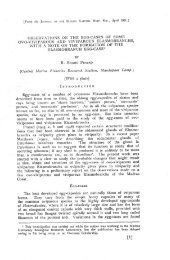PDF - Eprints@CMFRI
PDF - Eprints@CMFRI
PDF - Eprints@CMFRI
Create successful ePaper yourself
Turn your PDF publications into a flip-book with our unique Google optimized e-Paper software.
69<br />
Material :<br />
Northern R. S.: HLM Fri 109-1 (Sharm esh Sheikh, 95 m).<br />
Distri butio n : Red Sea ; Maldives; Indonesia; Palau Isis.; Great Barrier Reef; Marshall Isis. ; Fiji ;<br />
Samoa.<br />
Genus Gardineroseris SCHEER and PILLAI, 1974<br />
T Y pes p e c i e s : Agaricia (Undaria) plmlUlata DANA, 1846.<br />
G e n e ric c h a r act e r s : Encrusting, tending ro become massive. Cerioid with solid acute walls.<br />
Calices polygonal, mono- ro trisromodaeal. Corallites 4 ro 6 mm in diameter when monosromodaeal,<br />
2 ro 4 mm deep . epta numerous, higher cycles unite with the lower cycles before the latter unite with<br />
a styliform columella placed in the centre of a sma ll axial fossa. Septa subequal in thickness, arrangemenr<br />
more or less as in Siderasrreidae.<br />
The genus is known ro include a single species, G. planulata. 1901 VERRILL has given the first figure<br />
of the species. In 1905 GARDINER established a new species Agaricia ponderosa with a variety minikoiensis.<br />
VABE, SUGIYAMA & EGUCHI (1936) separated the two, but their Agaricia ? minikoiensis is<br />
idenrical with Leptoseris mycetoseroides. MA (1937) placed A. minikoie11sis in a new subgenus Agariciella.<br />
WELLS (1936) poinred out that planulata, ponderosa and var. minikoie1lSis are one and the same<br />
and placed them ro Pavona, subgenus Polyastra. UMBGROVE ( 1939 ) believed he could separate planulata<br />
and ponderosa on grounds of small differences in the columella.<br />
In the following years the name ponderosa was used: Pavona p. by MATTHAI (1948), Pavona (Polyastra)<br />
p. by DURHAM (1962), Agariciella p. by ROSEN (1971) and by LOYA & SLOBODKIN (1971), and<br />
finally Gardineroseris p. by SCHEER & PILLAI ( 1974). HEAD (1980) used again Agariciella p., while<br />
VERON & PICHON (1980) returned ro the older name planulata. The presenr authors think that ponderosa<br />
and planulata are the same, and that planulata has priority.<br />
While proposing the generic name we made two statements which are unscienrific, and we take this<br />
opportunity ro correct them . First, the septal arrangement of Gardineroseris is more like Siderasrreidae<br />
than Thamnasrreidae. Second, we made a statemenr to the effect that WELLS ' (1956) inclusion of Agariciella<br />
MA , 1937, in Leptoseris is incorrect. We regret this mistake, WELLS is fully justified.<br />
Agaricia<br />
Asteroseris<br />
Pavo,tQ (Polyastra)<br />
Gardjn ~roseris<br />
Agaricia<br />
Aga,icia ?<br />
PQvonQ<br />
PQf)onll (Poly·<br />
as/'lIJ<br />
Agariciella<br />
Cardjnero seris<br />
AgQridellll<br />
planulattJ<br />
planulata<br />
planulata<br />
pfanulata<br />
ponderom<br />
ponderoSQ<br />
Gardineroseris planulata (DANA ), 1846<br />
1846. DANA, lJ8.<br />
(Plate 14. Figs. 8 , 9)<br />
1901 , VERRILL, 156. pI. 27 /8,8a.<br />
1936. WELLS. 549; pI. 1011 - 3.<br />
1980, VERON&PICHON,68;figs. 12 1- 12S ; 14S.<br />
1905. GARDINER, 937: pI. 89/ S. 6.<br />
Vir. miniJwiens;s 1905 . GARDINER. 938; pI. 90/7.<br />
ponderosa 1936, YARE. SUGIYAMA & ECUCHI. 55; pis. 27/ S; 38/ 1; 52/1.<br />
ponderosa 1948. MATTHAI. 182; pI. 6 / 18 . 19 , 21 - 24.<br />
ponderosa 1962 . DURHAM, SO : fig. s.<br />
pondl!rosQ<br />
pondero sa<br />
ponderosa<br />
1971 . ROSEN. III.<br />
1911. LOVA & SLOBODKIN. 123.<br />
1914. SCHEER & PILLAl. 32 ; pI. IS/ I , 2.<br />
1976. PI LLAI & SC HEER. 41.<br />
1980. HEAD, 149. 451.<br />
Corallum encrusting, edges free thus looking like a folium . Underside wherever free is covered by an<br />
epitheca, which srops about 5 mm from the growing edge. Corallites 5 ro 7 mm in greater length, polygonal,<br />
with equal depth. Septa generally about 70, but up to 100 in a large calyx, subequal at the wall ;<br />
higher cycles unite with the immediate lower cycle. 14 to 17 septa reach the columella. Axial fossa about<br />
0.5 mm in diameter, sometimes filled by a styliform columella. Sides of septa minutely granulated .
















